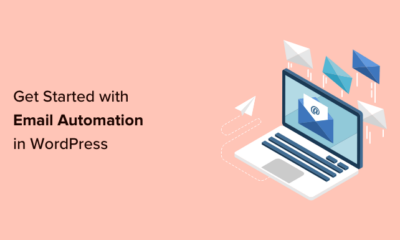EMAIL MARKETING
Hot or Not: Email Marketing Trends for 2021
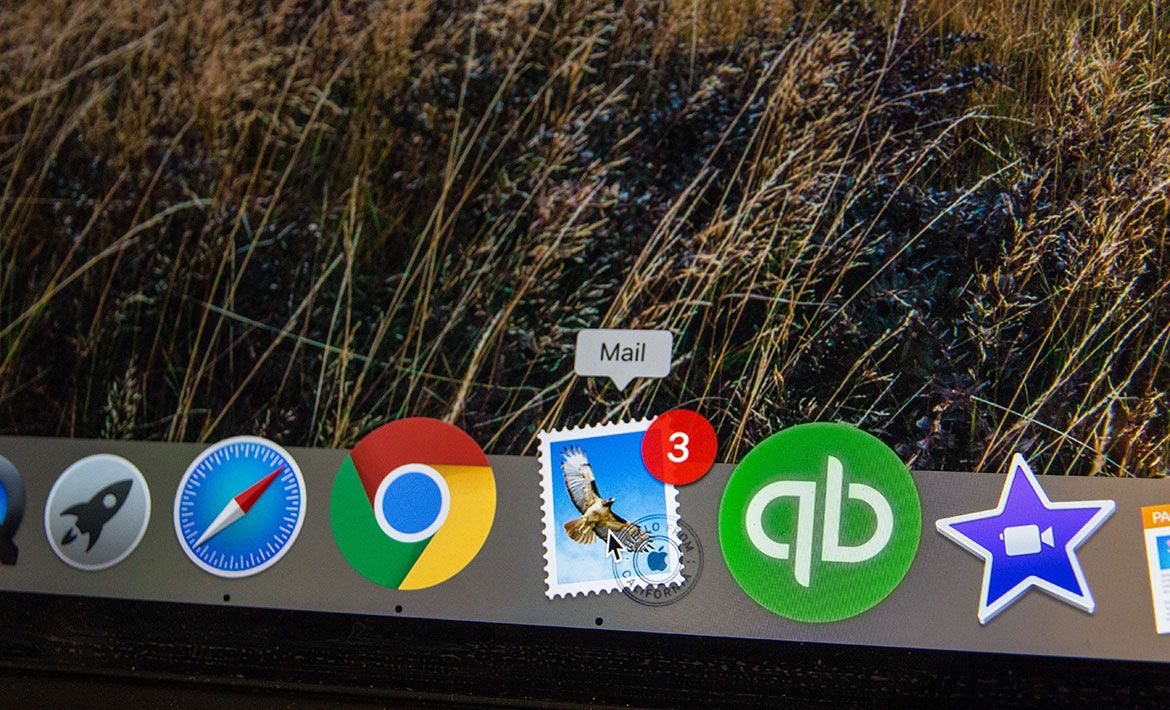
If there’s one thing the pandemic has made us realise, it’s that plans can change easily. Whatever it is you predict today, may not be accurate tomorrow. You need to constantly keep an eye on the latest trends and projections to stay ahead of the competition.
At the beginning of 2020, there were rumours that email marketing had one last breath to make. Then the pandemic hit, and the tables have turned. Over the last year, companies have swiftly shifted to digital channels, making email marketing hot again!
Email marketers are sending 27% more emails than they then did pre-coronavirus.
[HubSpot]
Absolutely Everything You Need to Know About Email Marketing [+ Templates]
While this is definitely good news, especially since email newsletter engagement figures have also grown, we need to be careful! To match your competition and ace your email marketing strategy, you need to stay on top of the latest trends.
NetHunt is ready to tell you what’s hot and what’s not in the year 2021!
1. Incorporation of Artificial Intelligence Into Email Marketing Practices
Artificial Intelligence (AI) is still a confusing concept for a lot of companies. Both marketing newbies and even more experienced marketers are sceptical about the use of AI for email marketing.
The truth is, there’s more data available online than any marketer could ever collect and process, even if they used advanced technology and edge-cutting software. Contrarily, AI is capable of dealing with this task with minimal effort applied.
List segmentation, content analysis and effective outreach: all the tasks that AI can already do better than humans. There’s also evidence that the scope of AI’s abilities is increasing (soon, it’ll be able to complete most human tasks), meaning it’s time to get a grip of how to use Artificial Intelligence to optimise your email marketing campaigns effectively.
2. Hyper-Personalisation of Email Marketing
There are a lot of different objectives an email marketing campaign can aim for, starting with raising brand awareness and ending with re-engaging customers. However, the end goal of any email marketing campaign is to generate more revenue and make more profit. Over the last couple of years, marketers have concluded that one of the best ways to do that is through complete personalisation.
This trend goes hand-in-hand with the previous one. The use of Artificial Intelligence makes it easier to assure personalisation by obtaining more data about your customers. Regular customers are becoming more and more aware of the volume of information collected about them. Naturally, they expect it to be used to accommodate their needs better; they only agree to give up their personal information in exchange for better-personalised offers.
Unfortunately, there are still companies that fail to grasp the importance of personalisation in email marketing. According to research conducted by Janrain and Blue, almost all consumers (96%) have received mistargeted information or promotions. The most common types of mistargeted email content include:
- “An offer that clearly shows they do not know who I am,” experienced by 71% of customers.
- “Mixed info across different methods of communication,” experienced by 51% of customers.
- “‘Mistakes made about basic information about me,” experienced by 41% of customers.
All of these mistakes can have severe detrimental effects on the outcome of your campaign. Upon receiving a non-personalised or mistargeted email, 94% of customers report taking at least one of the following actions:
- 68%: Automatically delete emails.
- 54%: Unsubscribe from emails.
- 45%: Categorize emails as ‘junk’ or ‘spam’.
- 29%: Become less willing to buy products.
- 13%: Visit the website less frequently.
- 10%: Never visit the website again.
Lack of email marketing campaign personalisation can result in anything from mailing list degradation, to an overall failure of the email marketing campaign because of skyrocketing costs.
Besides, personalisation has several other statistically-proven benefits:
- Birthday emails are capable of generating roughly 342% more revenue/email than a regular promotional email. [Experian]
- Personalised messages have an ROI of 122%. [Instapage]
- Personalised subject lines can generate approximately 50% higher open rates than standard subject lines. [Oberlo]
This trend is particularly hot, and the importance of personalisation strengthens every day. That’s why the business world is expected to focus on email marketing hyper-personalisation in 2021, as opposed to just personalising parts of campaigns. Here’s how to get the most out of this trend:
- Tailoring messages and promotions by audience segment;
- Recommending products or content by audience segment;
- Use of triggered emails sent based on visitor/ user/ shopper behaviours;
- Recommended products or content per individual.
3. Email Marketing Automation: The Power of Drip Campaigns
Traditionally, email marketing campaigns consist of several separate emails, all of which are controlled by a marketer. It’s up to the marketer to decide when and why a specific email is sent to mailing list subscribers.
In 2021 that’s going to change. Email marketing is stepping away from manual campaigning and using automation more often.
Email marketing automation (aka drip campaigns) refers to an email marketing strategy that uses sequences of trigger-based emails instead of one-time shots. This ensures consistent and cohesive communication between the subscribers and the company. Moreover, it gives the customer a sense of control over their inbox. In today’s world of content overload, the last thing a person wants to see in their inbox is yet another useless and uncalled for email. No matter how great the content is, it feels intrusive and spammy when it comes out of the blue.
That’s why drip email campaigns tend to perform better than regular email campaigns. Specific actions taken by users activate the launch of the sequence. Emails that get sent out as a part of a drip campaign are more responsive and create a much ‘friendlier’ communication between each side. They are not overwhelming; all the necessary information comes in ‘drips’, saving effort of having to traipse through a hefty copy. The customer gets the exact piece of information they expect to receive.
Automated emails enjoy 119% higher click rates than broadcast emails.
[Epsilon]
Now, there’s a conflict of interests. On one hand, we have consumers. No one wants their inbox to be clogged. People are sick and tired of moving boring and irrelevant emails to the trash folder in bulk. On the other, there are stats to prove that retailers who send a series of welcome emails see 13% more revenue than those who give up after sending just one. [Internet Retailer 500] This means you’re missing out on a valuable opportunity if you stop at just one email.
The only viable solution here is to only send emails when you know that the recipient is interested in getting them. A drip campaign does exactly that! Behaviour-based email automation can help you improve your email marketing results in 2021, as it effectively solves the conflict of interests.
If you want to provide the most accurate automated emails, you need to organise the process. To be in control of all the processes, you should delegate the task to a dedicated CRM system. This way, you’d have a chance to know who, what and where is happening along your sales pipelines.
4. User-Generated Content
Another big trend that emerged earlier this year, and is expected to reach its full potential in 2021, is utilising user-generated content in email marketing campaigns. User-generated content (UGC) is any form of content (text, videos, images, audio) created by end-users of goods or services.
There’s evidence to suggest that user-generated content promotes conversion. A large portion of consumers (82%) claim that user-generated reviews are extremely valuable. Roughly 70% of all consumers base their purchasing decision on the reviews and ratings from other users. Therefore, when email marketers include these in their emails, they amp up the levels of trust towards the products or services promoted.
Moreover, UGC can also act as content in itself. If you’re struggling to meet your email content quotas, you can always rely on user content to spice up your campaign.
5. Interactive Emails
This trend has already been around for a while but is only going to grow stronger in 2021. Interactive responsive emails are the holy grail of email marketing. They boost customer engagement and significantly increase email interaction.
Some interactive email elements that are expected to sizzle in 2021:
- Animated buttons and CTAs;
- Rollover effects to showcase product offerings;
- Interactive image and product carousels, controlled by the user;
- Accordion features designed to make long-form emails more compact;
- Surveys, polls and user-generated interactive content.
All of these are rightly connected with another interactive email marketing trend – email marketing gamification. Gamified solutions offer a competitive advantage by standing out among the rest of the emails in a subscriber’s inboxes.
6. Email Redesign
You must have seen this one coming. Email design is by far one of the most fluid and dynamic parts of email marketing. It’s creative and extremely subjective, which means it’s prone to be influenced by a lot of external factors.
Every year, fashion weeks around the world offer us an insight into what’s going to be trendy in the upcoming seasons: the most fashionable colours, fabrics and silhouettes. The same way, web-design trends change from season to season, dictating how a successful email copy should look like.
However when it comes to email marketing, there’s more reasoning behind a sudden change in the appearance of emails than just aesthetics. Today, 81% of people across each demographic check their emails using a mobile device. To remain relevant, email marketers need to adjust their copy to fit the screen of smartphones.
In 2021, the hottest email design trends cover the following areas…
- Minimalism. A lot of marketers predict that the public love for minimalism will soon reflect itself in email campaigns. Uncluttered, well-structured emails with a single objective and minimum irrelevant details are going to reign supreme in the upcoming year.
- Dark-mode. Ever since Apple introduced the dark mode, it has become the new norm to give people a chance to embrace their inner goths, ahem, adjust the brightness and look at the screen without having to squint from how bright it is.
- Bright and bold colours. It’s all about making yourself seen. While you don’t want to overload an email with too much imagery, you definitely want to attract a subscriber’s attention with daring colour blocks.
7. Focusing on Privacy
When the General Data Protection Regulation (GDPR) was launched in 2018, the world of email marketing changed. Still over the past two years, it has still not adjusted to the new realities completely. In 2021, focusing on data privacy remains an ongoing email marketing trend.
Only 8% of consumers trust brands to keep their personal information safe.
[NTT data]
Being thoughtful and providing your subscribers with an option to unsubscribe from mailing lists ensures a list remains fresh. As people who no longer want to receive messages from you leave, you can focus better on those who stay and attract new subscribers who’re interested in what you’ve got to offer.
You should review all the legislation regarding electronic privacy, and include all the elements in future email marketing campaigns to ensure compliance.
All in all, we can already say that 2021 is about to be a challenging, but interesting year. There are a lot of brand new trends emerging and older ones still in full force. It’s up to you, whether you’re going to take advantage of them and slay the competition. Good luck!
Originally published November 06, 2020, updated December 24, 2020
Author: Valerie Kakovkina – December 24, 2020
EMAIL MARKETING
Unveiling the Future of Email Marketing: 4 Trends to Revolutionize Engagement
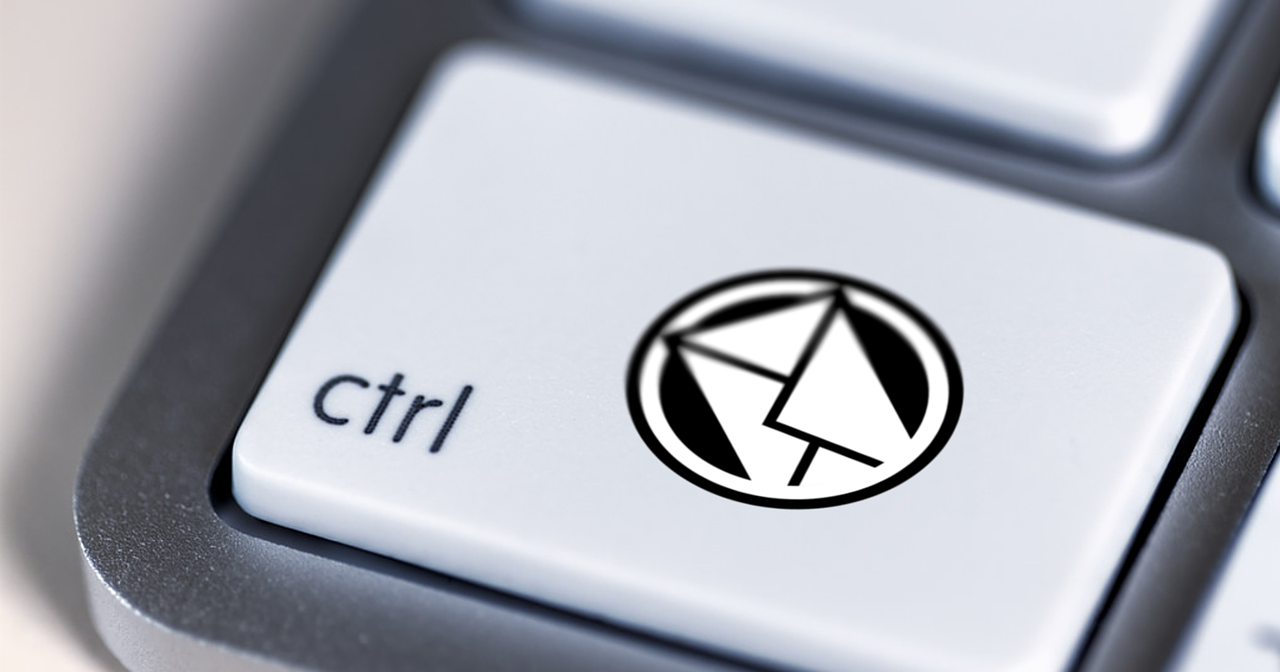
In today’s fast-paced digital landscape, the efficacy of email marketing hinges not only on the delivery of messages but also on their ability to resonate with audiences and drive meaningful interactions. Gone are the days of generic blasts; instead, companies are increasingly turning to innovative strategies to captivate their subscribers. Here, we delve into four emerging trends poised to redefine the realm of email marketing, promising to elevate engagement and drive conversions.
1. User-Generated Content (UGC) Takes Center Stage
User-generated content (UGC) emerges as a potent tool in the arsenal of email marketers, facilitating authentic connections with audiences while amplifying brand visibility. From customer reviews to social media posts, UGC offers a dynamic and relatable portrayal of products and services, resonating with consumers in the era of “new sincerity.”
By harnessing UGC within newsletters, brands gain invaluable insights into consumer preferences and behaviors, fostering trust and credibility. Strategies such as incentivized contests or social media challenges empower users to contribute content willingly, fueling a steady stream of authentic engagement.
2. Augmented and Virtual Realities (AR/VR) Transform Experiences
Augmented reality (AR) and virtual reality (VR) technologies emerge as game-changers in the realm of email marketing, offering immersive experiences that captivate and compel audiences. While VR may require substantial investments and specialized equipment, AR presents a more accessible avenue for brands to showcase products and drive engagement.
From interactive product demonstrations to virtual try-on experiences, AR/VR initiatives promise to revolutionize email campaigns, offering users a glimpse into a digitally enhanced world. While technical constraints may limit current implementations, ongoing advancements herald a future where AR/VR seamlessly integrate into email communication, enriching brand experiences.
3. Omnichannel Integration Enhances Connectivity
The advent of omnichannel marketing heralds a new era of seamless connectivity, enabling brands to orchestrate cohesive experiences across diverse touchpoints. By unifying customer interactions across websites, offline stores, and email communications, businesses cultivate deeper insights and deliver personalized content tailored to individual preferences.
Omnichannel integration not only streamlines the customer journey but also fosters brand loyalty by offering consistent and personalized experiences. Whether browsing online, engaging in-store, or interacting via email, customers encounter a unified brand identity, enhancing engagement and driving conversions.
4. Hyper-Segmentation and Personalization Drive Relevance
In an age defined by personalized experiences, hyper-segmentation emerges as a cornerstone of effective email marketing strategies. By dissecting audiences into granular segments based on demographics, behaviors, and preferences, brands can deliver tailored content that resonates on a profound level.
Utilizing advanced email marketing platforms, businesses can leverage hyper-segmentation to craft personalized campaigns that speak directly to individual interests and needs. From dynamic product recommendations to targeted promotions, personalized emails foster a sense of relevance and exclusivity, driving engagement and fostering long-term customer relationships.
In conclusion, the future of email marketing lies in innovation and adaptation, with brands leveraging cutting-edge technologies and strategic approaches to engage audiences effectively. By embracing trends such as user-generated content, augmented reality, omnichannel integration, and hyper-segmentation, businesses can unlock new realms of engagement, driving meaningful interactions and fostering brand loyalty in an ever-evolving digital landscape.
EMAIL MARKETING
Top Email Marketing Strategies To Use For Q4
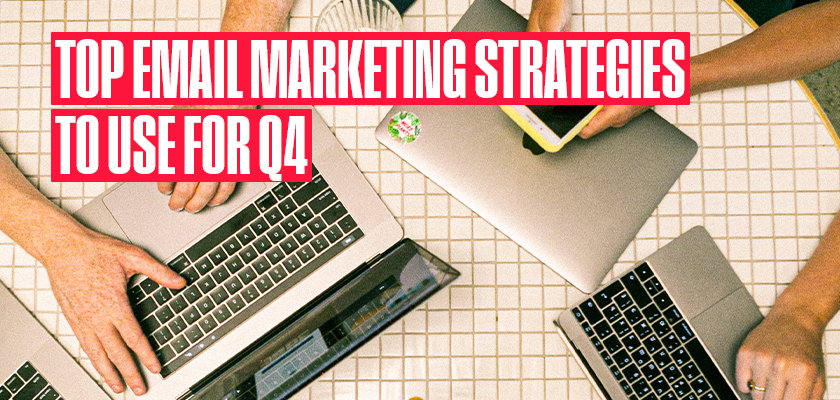
As we approach the Q4 period, it’s never too early to start preparing for your Black Friday and Cyber Monday email marketing strategy. Once Black Friday week hits, our inboxes are filled with a hurricane of brands fighting for attention, each with the ‘biggest’ and the ‘best’ offers you won’t get anywhere else.
To set your brand apart from the competition, it’s crucial to plan ahead. Over 60% of brands send out multiple emails over the course of the Black Friday/ Cyber Monday weekend, and it’s a perfect time to up your brand awareness ahead of the Christmas shopping season.
If you’re not sure where to start with Q4 planning or need some last-minute tips to enhance your strategy, we’ve outlined some top email marketing strategies to incorporate into your plans!
1. Send Pre-Black Friday Emails
Sending pre-Black Friday emails is great for keeping your brand at the forefront of people’s minds ahead of the big day. Not only will a pre-Black Friday email let your audience know about your upcoming event, but it will also ensure that your audience is regularly checking in on your brand throughout the Q4 period.
Additionally, sending pre-Black Friday emails is beneficial for A/B testing. Sending out different formats of emails with minor tweaks, such as the CTAs or subject lines, can help you determine what your audience is more likely to engage with so you can then tailor your Black Friday strategy accordingly.
2. Run a Lead Gen
It might seem like a given, but ahead of Black Friday, it’s beneficial to give your email list a much-needed boost. A simple but effective way to do this is to run a lead-generation advertising campaign. For example, offering your audience the chance to win a prize in return for submitting details, such as their email address, is a quick and easy way to increase your list size. Similarly, refreshing your pop-up on-site with an irresistible offer will also contribute to gaining new profiles.
3. Offer Something Unexpected
Email marketers only have 3 seconds to capture the attention of their readers, which isn’t surprising due to the amount of emails the average person will receive daily. If an email isn’t driving you to click on it, it swiftly gets forgotten about and lost within their inbox. Over Black Friday, to avoid this happening, make sure you’re offering something unexpected, whether that’s a mystery discount or a gift with each purchase!
One of the worst things you can do over Black Friday is to overcomplicate your promotions. If you’re offering multiple promotions and codes, things can get a bit too hectic. To make it as simple as possible, consider running a standard “up to” percentage amount. If you want to include a code, it helps to have this auto-applied at checkout to avoid customers dropping off if they input it incorrectly. In the design of your email, make sure the promotion is clearly highlighted within the design so it can’t be missed, and also referenced in the body copy and subject lines too!
5. Create An Effective Design
Creating an effective design is one thing, but how do you know what works? To improve your email campaigns, consider running an A/B test to pinpoint which elements of your design are improving the CTR and which are hindering it.
Highlighting metrics such as colour, font size, and CTAs can instantly impact whether people will click through or discard! If a consumer clicks on your email, you’ll have, on average, 11 seconds to keep their attention, so making sure your design stands out for the wave of other Black Friday content is key! Keep the design of your email reflective of your branding but with stand-out elements specifically for the shopping season.
6. Make Use Of CTAs
CTAs (call-to-action) are one of the most underrated parts of any email campaign, especially over the Black Friday period. They’re one of the driving forces behind making your email recipients turn into passive readers to customers. One key way to make your CTAs stand out is to make use of bright and bold colours that will attract and hold attention. Additionally, it’s important to think about the placement of your CTAs to increase your click-through rate, make sure the copy used is clear and concise (between two and five words) and use actionable language.
7. Focus On Subject Lines
Subject lines are make or break for every email campaign. Over Black Friday, consumers’ inboxes are cluttered with emails, so it’s important to stand out. It’s estimated that on Black Friday, 116.5 million emails from brands were sent out (more than any other day), and Black Friday sees the highest number of emails opened and clicked. To prevent your emails from being lost in the void, having a cracking subject line to stand out from competitors is everything.
The secret to a great subject line is to keep it short and snappy. On average, subject lines with 50 characters or less tend to get an average of 12% higher open rates and 75% higher click-through rates. Including emojis within subject lines has been seen to increase click-through-rates by as much as 28%!
Additionally, it helps to use language that will really pique your audience’s interest, stay away from any overused cliches and keep them as attention-grabbing as possible.
8. Prep for Cyber Monday
To plan an effective Black Friday, it’s crucial to prepare for Cyber events too. With Cyber following straight after, it’s easy to forget about it or not prioritise it as much as Black Friday, however, it’s still an extremely profitable day! To make the most of it, create dedicated campaigns and tailor your online sales messaging so that it focuses on driving urgency.
9. Incorporate SMS into Your Strategy
Sometimes the importance of SMS can be overlooked because a lot of brands assume that text messages won’t fit in with their brand. However, it’s a no-brainer for reaching even more customers. On average, 82% of people engage with marketing content on their smartphones, so it’s something to definitely explore, especially over the busy shopping period.
To gain SMS sign-ups, you can effectively tie your SMS campaign in with your lead generation and ask for customers to fill out their phone number as well as their email address. That way, they’ll be opted into your send list. It can also be used to send reminders when sales have launched or when offers are coming to a close.
Despite having only 160 characters to work with, SMS campaigns are longer than recommended email subject lines, so it can be just as, if not more effective than email marketing campaigns.
EMAIL MARKETING
Mastering Email A/B Testing for Mobile Apps: The Ultimate Guide
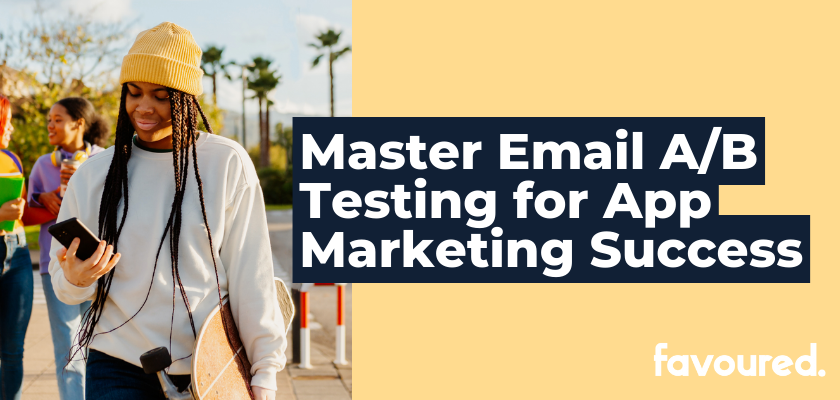
Welcome to the world of email A/B testing for mobile apps!
Here at Favoured, we’re all about delivering the best results for our clients, and that includes mastering the art of email marketing. In this guide, we’ll take you through the essentials of A/B testing your email campaigns to achieve maximum success for your mobile app.
What Is Email A/B Testing?
Email A/B testing, also known as split testing, is a method used to compare two or more variations of an email campaign to determine which one performs better. The goal is to identify the version that resonates most with your target audience, ultimately leading to higher open rates, click-through rates, and overall engagement.
In the context of mobile apps, email A/B testing can be particularly valuable, as it helps you fine-tune your marketing messages to drive user acquisition, engagement, and retention.
Benefits Of Email A/B Testing
There are numerous advantages to incorporating A/B testing into your email marketing strategy for mobile apps. Some of the key benefits include:
- Improved open rates: By testing different subject lines, you can identify which ones capture your audience’s attention and entice them to open your emails.
- Increased click-through rates: Experimenting with various email elements, such as CTAs and layout, can help you determine the most effective ways to encourage recipients to take action.
- Enhanced engagement: A/B testing allows you to create more relevant and engaging content for your target audience, resulting in higher conversion rates and stronger user relationships.
- Data-driven decision making: With A/B testing, you can make informed decisions based on actual user behaviour, rather than relying on assumptions or gut feelings.
Key Metrics To Track
When conducting email A/B tests, it’s essential to track specific metrics to gauge the success of your campaigns. Some of the most critical metrics to monitor include:
- Open rate: The percentage of recipients who open your email. This metric can help you evaluate the effectiveness of your subject lines.
- Click-through rate (CTR): The percentage of recipients who click on a link within your email. A high CTR can indicate that your email content is engaging and relevant.
- Conversion rate: The percentage of recipients who take the desired action after clicking a link in your email, such as downloading your app, making a purchase, or signing up for a newsletter.
- Unsubscribe rate: The percentage of recipients who opt out of receiving future emails from you. A high unsubscribe rate may suggest that your email content is not resonating with your audience.
Understanding the basics of email A/B testing is the first step towards optimising your mobile app marketing campaigns. By grasping the concept, benefits, and key metrics of A/B testing, you’ll be well-equipped to make data-driven decisions that drive real results for your mobile app.
Setting Up Your Test
Defining Your Goal
Before you start setting up your A/B test, it’s crucial to determine the primary objective of your test. Having a clear goal will help you focus your efforts and make data-driven decisions based on the results. Your goal should align with your overall mobile app marketing strategy and be specific, measurable, attainable, relevant, and time-bound (SMART). Examples of goals for email A/B tests include:
- Increasing the open rate by 10% within 30 days
- Boosting the click-through rate by 15% within 60 days
- Reducing the unsubscribe rate by 5% within 45 days
Selecting Variables To Test
Once you’ve set your goal, it’s time to choose the variables to test in your email campaign. The variables you select should have a direct impact on your goal and be something you can measure. Here are some common email elements to consider testing:
- Subject lines: Test different wording, phrasing, or personalisation techniques to capture your audience’s attention.
- Email content: Experiment with different content styles, lengths, or structures to see what resonates with your recipients.
- Call-to-action (CTA): Try various CTA placements, wording, or button designs to encourage users to take the desired action.
- Images and visuals: Test different images, colours, or visual layouts to determine which one drives higher engagement.
- Personalisation: Compare personalised content, such as using the recipient’s name, to generic content to assess its impact on your metrics.
Creating Variations
Now that you’ve chosen your variables, it’s time to create the variations for your email campaigns. Keep the following tips in mind when crafting your variations:
- Limit the number of variations: While it may be tempting to test multiple variations, it’s best to limit yourself to two or three, so you don’t dilute your results or prolong the testing process.
- Make distinct changes: Ensure the variations are different enough to provide meaningful insights. For instance, if testing subject lines, one could be a question, while the other could be a statement.
- Keep other elements consistent: To ensure accurate results, only change the variable you’re testing and keep all other elements the same across variations.
- Consider your audience: When creating variations, take into account your target audience’s preferences and behaviours to craft relevant and engaging content.
Setting up an A/B test for your mobile app’s email campaigns is an essential step towards optimising your marketing efforts. By defining your goal, selecting the right variables to test, and creating effective variations, you’ll be well on your way to enhancing your app’s performance and building stronger relationships with your users.
Implementing & Analysing Your Test
Test Duration & Sample Size
Determining the optimal test duration and sample size is crucial for obtaining accurate and reliable results. Here are some factors to consider when deciding on these parameters:
- Test duration: The length of your test should be long enough to gather sufficient data, but not so long that it delays your marketing efforts. Generally, a test duration of 7 to 14 days is recommended for most email A/B tests.
- Sample size: Your sample size should be large enough to provide statistically significant results. Use an A/B test sample size calculator to determine the appropriate size based on your desired confidence level and the expected difference between variations.
Keep in mind that these recommendations may vary depending on your specific circumstances, such as the size of your email list or the frequency of your email campaigns.
Launching Your Test
Once you’ve determined the test duration and sample size, it’s time to launch your A/B test. Follow these steps to ensure a smooth test launch:
- Segment your email list: Divide your email list into random, equal-sized groups to ensure a fair comparison between variations.
- Send your variations: Schedule your email campaign to send the different variations to the corresponding segments of your email list.
- Monitor the progress: Keep an eye on the key metrics, such as open rates, click-through rates, and conversion rates, throughout the test duration to ensure everything is running smoothly.
Analysing Results & Drawing Conclusions
After your test has concluded, it’s essential to analyse the data, draw conclusions, and apply your findings to future email campaigns. Here’s how to go about it:
- Review the data: Examine the key metrics for each variation and compare them to determine which one performed better.
- Check for statistical significance: Use an A/B test calculator to ensure the differences between the variations are statistically significant, indicating that the results are not due to random chance.
- Draw conclusions: Based on the data, determine what you’ve learned from the test and how it can inform your future email marketing efforts. For instance, if a specific subject line format led to higher open rates, consider using a similar approach in future campaigns.
- Apply your findings: Incorporate your learnings into your email marketing strategy to continually optimise your campaigns and drive better results for your mobile app.
Implementing and analysing your email A/B tests is a critical step towards optimising your mobile app marketing campaigns. By determining the appropriate test duration and sample size, launching your test, and analysing the results, you’ll be able to make data-driven decisions that enhance your app’s performance and foster stronger relationships with your users.
Best Practices
Consistent Testing
To achieve long-term success in email marketing for mobile apps, it’s crucial to make A/B testing a consistent part of your strategy. Regular testing allows you to:
- Continuously optimise your campaigns: Stay ahead of the curve by continually refining your email campaigns based on data-driven insights.
- Adapt to changing trends: Keep your email marketing efforts relevant and up-to-date by adapting to evolving user preferences, industry trends, and market dynamics.
- Validate new ideas: Use A/B testing to validate new marketing concepts or tactics before fully implementing them in your campaigns.
Avoiding Common Pitfalls
As with any marketing endeavour, there are potential pitfalls to watch out for when conducting email A/B tests. Here are some common mistakes and how to avoid them:
- Testing too many variables at once: Focus on testing one variable at a time to ensure accurate results and avoid confusion when analysing the data.
- Ignoring statistical significance: Make sure your test results are statistically significant to avoid drawing conclusions based on random chance or insufficient data.
- Focusing solely on short-term gains: While it’s essential to optimise for immediate results, also consider the long-term impact of your email marketing strategy on user retention and lifetime value.
Utilising Automation & Growth Hacking Strategies
Leveraging automation and growth hacking techniques can help streamline your email A/B testing efforts and drive even better results for your mobile app. Consider the following strategies:
- Email automation: Use email marketing automation tools to schedule and send your A/B tests, track key metrics, and segment your email list efficiently.
- Dynamic content: Implement dynamic content in your email campaigns to personalise messages based on user behaviour, preferences, or demographics, and A/B test the effectiveness of various personalisation techniques.
- Multivariate testing: Once you’re comfortable with A/B testing, consider using multivariate testing to assess the impact of multiple variables simultaneously and identify the best combination of elements for your campaigns.
Mastering email A/B testing for your mobile app is an ongoing process that requires consistent effort, learning, and adaptation. By following best practices, avoiding common pitfalls, and utilising automation and growth hacking strategies, you’ll be well on your way to achieving long-term success in your email marketing campaigns.
As a data-driven full-funnel marketing agency, Favoured believes in the power of optimising every aspect of the customer journey, and that includes email marketing.
We’re dedicated to helping businesses drive real results, and A/B testing plays a crucial role in this process. Reach out if you want to supercharge your email campaigns with us. Happy testing!
-

 PPC4 days ago
PPC4 days ago19 Best SEO Tools in 2024 (For Every Use Case)
-

 PPC7 days ago
PPC7 days ago4 New Google Ads Performance Max Updates: What You Need to Know
-

 SEO6 days ago
SEO6 days agoGoogle Clarifies Vacation Rental Structured Data
-

 MARKETING6 days ago
MARKETING6 days agoWill Google Buy HubSpot? | Content Marketing Institute
-
SEARCHENGINES6 days ago
Daily Search Forum Recap: April 16, 2024
-

 PPC7 days ago
PPC7 days agoShare Of Voice: Why Is It Important?
-

 PPC6 days ago
PPC6 days agoHow to Collect & Use Customer Data the Right (& Ethical) Way
-

 MARKETING5 days ago
MARKETING5 days agoStreamlining Processes for Increased Efficiency and Results










